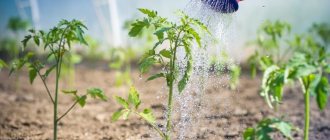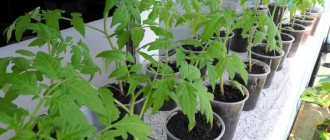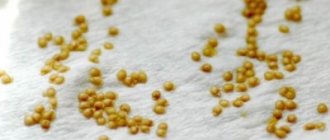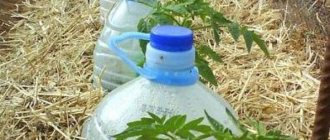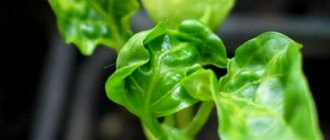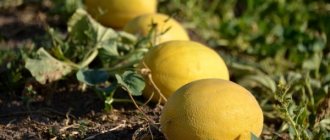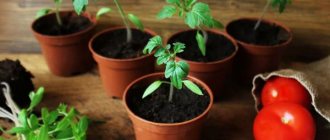Every gardener dreams of growing high-quality, good-quality seedlings, because this determines how fruitful the plant will be. Few people know how often and with what it is necessary to water tomato seedlings, because this crop becomes susceptible to various diseases if not properly cared for. The watering process should be carried out carefully, with a certain amount of liquid.
How often to water tomato seedlings
The question is far from idle, and some gardeners are faced with a problem when tomato seedlings begin to break at the base and fall. The problem lies in waterlogging of the soil.
Tomatoes are a drought-resistant crop. Its root can go 1.5 m deep into the soil, and naturally there is always moisture there. Therefore, tomato seedlings in open ground are watered rarely, but abundantly. Things are somewhat different when grown at home.
On average, seedlings are watered once every 4-5 days in sunny weather and increase the interval to 6-8 days on cloudy days.
Of course, soil structure plays an important role. Moisture evaporates from a light and loose substrate much faster, which means watering should be more frequent.
After planting the seeds
How to determine whether plants need irrigation? At the stage of seed germination, gardeners try to create optimal conditions for this. Stretch plastic film over the seedling boxes, cover them with glass, or use purchased mini-greenhouses equipped with transparent plastic lids.
In such conditions, additional moisture is rarely required. But in case of doubt, the surface is wetted with a spray bottle.
After germination
After the appearance of mass shoots, the shelters are removed, but no watering is carried out. There is still moisture in the soil that was introduced when sowing the seeds, and the roots will be drawn to it, gaining volume and strength. And after 3-5 days the sprouts should be watered. Small containers are watered with a teaspoon, syringe and even a pipette.
But when growing a large volume of seedlings, such methods are not suitable. A small watering can with a long spout works best.
It is good if seedlings are grown in transparent containers where the condition of the soil can be seen.
For plastic and wooden seedling boxes, you can use a simple device:
- Make a hook from a piece of strong wire (15-20 cm), bending it 1-2 cm in length.
- The device is immersed in the soil along the wall of the vessel to the base, slightly turned and removed.
- By kneading the caught lump in your fingers, you can determine whether to water it now or postpone the procedure for a day or two.
However, it should be noted that this method is applicable only to very young seedlings, when the root system has not yet entwined the earthen ball. It is during this period that there is the greatest risk of soil waterlogging, which leads to blackleg disease.
In any case, all planting containers must be equipped with drainage holes. As soon as water begins to ooze from them, it means that the earth is saturated with moisture.
As the seedlings grow, the need for water increases. Seedlings ready for picking are watered a day or two before this procedure. It is necessary that the soil dries out a little and during work easily separates from the roots without causing harm to them.
The sprouts are also planted in moist soil, accompanied by light watering. This is necessary so that the thin threads of the root system are in close contact with the ground.
How to water tomato seedlings after diving
Correctly carried out picking of tomato sprouts will provide them with the necessary level of humidity for the first 4-6 days. At this time, the boxes with seedlings are somewhat shaded so that rooting takes place more calmly. Further watering is carried out at approximately the same frequency.
For watering, it is advisable to use a small watering can with a long narrow spout; such equipment can easily be placed between tomato bushes.
- If seedlings are grown in individual containers, then water is slowly poured closer to the walls of the vessel. It is necessary to ensure that the root system is not exposed. If necessary, add soil to the cups.
- In common boxes, seedlings are watered between the rows, preventing water from getting on the leaves.
The sun's rays falling from the window can cause them to burn. Therefore, it is recommended to water tomato seedlings grown at home either in the evening or early in the morning.
And 2 weeks after the dive, watering is combined with fertilizing. The choice of fertilizer depends on the location of the seedlings. It is unlikely that a gardener will want to plant an infusion of mullein or bird droppings in an apartment. Although this is the best option for the first feeding, it is still better to use it in greenhouses.
At home, you can use an infusion of wood ash (1 tablespoon per 1 liter of water). Tomatoes respond very well to this natural fertilizer.
Among the industrial preparations used:
- "Agricola";
- "Intermag vegetable garden";
- "Gumi Kuznetsova";
- "Ideal";
- "Baikal EM 1".
Specialized stores offer a very wide selection of mineral fertilizers for feeding tomato seedlings.
When applying fertilizer, you need to be careful and not allow the solution to get on the leaves. If this happens, wash it off using a spray bottle. Fertilizing is done on moist soil, spending 100-120 ml per plant.
The gardener will have to take care of the soil moisture in the seedling boxes for more than 2 months. At this age, the tomato bushes will be ready to be transplanted into open or protected ground.
Before planting in open ground, seedlings are hardened for 2 weeks, and a few hours before the planned work, they are watered, but not to the point of dirt. The next watering will be carried out in a permanent place: in an open-air garden bed or in a greenhouse.
General rules
The further growth of the vegetable crop depends on proper watering of seedlings.
Knowing the peculiarities of soil moisture, you can protect tomatoes from various diseases and prevent drying out or rotting of the root system.
How to water seedlings
3 days after the seeds are sown in the ground, they must be soaked with water. If the top of the soil is dry, this should be done earlier. Regular spraying of sprouted seeds will be no less useful, but you should not overdo it - the water must be able to evaporate, otherwise the seedlings will rot.
The rest of the time, seedlings should be watered when a crust forms on the ground. This must be carefully monitored and the required moisture balance maintained.
It is recommended to spray with fertilizers no more than once every 4 weeks.
A couple of days before picking tomatoes, you should moisten the soil so that it dries out a little and has a crumbly structure.
Do not forget that in the container where the seeds grow, it is always necessary to make drainage holes, thanks to which excess water will gradually drain away.
Watering seedlings after picking
After this procedure, the plant needs to rest; 5 days will be enough. Subsequent watering (once every 7-10 days) depends on the size of the bush and the age of the seedlings.
Each time the tomato will require more moisture.
After the diving procedure, the soil should be moistened from the pallet. Thanks to this, the tomato will have strong and branched roots.
Watering tomato seedlings
Folk fertilizers are not inferior in efficiency to industrial fertilizers, but at the same time they cost almost nothing. Recipes inherited by summer residents from previous generations pass from mouth to mouth and help to grow strong and healthy seedlings.
Iodine
Experts have not thoroughly studied the effect of iodine on the plant, but the positive effect of using such fertilizing has long been confirmed experimentally. The element does not directly affect the growth processes of tomatoes, but is a catalyst for the absorption of nutrients and helps strengthen the immune system. In the case of seedlings, iodine is used only until the ovaries appear. After its influence, plants develop better, get sick less, and subsequently produce a bountiful harvest.
It is important to follow the correct dosage of iodine fertilizer. In large quantities, the substance has a toxic effect on plants. It is recommended to water the seedlings with water with the addition of iodine 7 days after the first fertilizing with mineral complex fertilizer. To prepare the solution, 1 drop of iodine is dissolved in 3 liters of water. You need to water the seedlings with this product through a strainer, irrigating the leaves and the top layer of soil.
On a note! Before planting the seedlings in a permanent place, the soil is watered with an iodine solution prepared in the same proportion as for watering the seedlings. This will disinfect the soil and help the plants take root better. This manipulation should be carried out a day before the transplant.
Yeast
Yeast contains a lot of substances beneficial to plants and additionally improves the soil structure after application. Under the influence of the yeast solution, the growth rate of tomatoes increases, disease resistance improves, and productivity increases.
This fertilizing can be used at any stage of crop cultivation, but it is better to start doing this at the seedling stage. Yeast has an equally good effect on the development of the above-ground and underground parts of seedlings, helping them become stronger and recover faster after picking. Yeast does not cause any harm to the soil and plants, so you can safely use it.
To prepare the solution, use 50 g of fresh yeast or 5 g of dry yeast per 5 liters of water. Additionally, you can add 1 tbsp. spoon of sugar. All ingredients must be mixed and the mixture allowed to brew for 2-3 hours. Before use, the fertilizer is diluted in a ratio of 1:5.
Hydrogen peroxide
Hydrogen peroxide is used to stimulate the growth of tomato seedlings and prevent diseases. The product disinfects the soil well and prevents the proliferation of pathogenic microorganisms in it. Peroxide, as peroxide is also called, helps fill the roots with oxygen and neutralizes nitrates contained in the soil.
After watering with peroxide, iron and manganese salts that are useful for tomatoes are restored in the soil. The first feeding is carried out 2-3 weeks after emergence. In the future, the plants are watered with the product once a week. To prepare the fertilizer, mix 1 tbsp. spoon of hydrogen peroxide with 1 liter of water. The composition must be prepared immediately before use; it cannot be stored.
Preparing tomato seeds for planting:
Before sowing seeds for seedlings, they must be soaked in a nutrient solution. To prepare such a solution, you need to dilute in 1 liter of water: - 1 teaspoon of wood ash, or -1 teaspoon of nitrophoska, or -2 grams of the drug "Bud", or -1 teaspoon of liquid fertilizer "Effekton", or -1 teaspoon liquid fertilizer "Agricola-vegeta". The seeds need to be soaked in fabric bags for 24 hours at a solution temperature of at least 25 degrees. . Then, to harden the seeds, this moist bag of seeds should be placed in a plastic bag and placed in the refrigerator (but not in the freezer) for 1 - 2 days. Cooled seeds should be sown immediately into the soil. In this case, they will give friendly and quick shoots.
How to make drip watering of tomato seedlings on a windowsill with your own hands
Drip watering of tomato seedlings on the windowsill is very convenient. This method allows you to deliver moisture to plants literally drop by drop, simultaneously avoiding dryness and waterlogging of the soil. You can make your own drip irrigation system using plastic bottles and dropper tubes equipped with a clamp.
The container with water will need to be placed above the container with the seedlings, on a small stand or shelf. The tube from the injection system is connected at one end to the bottle, and the other end is inserted into the ground to a depth of several centimeters. The water supply speed is controlled by a clamp. The method is convenient in that you can moisten several containers with seedlings from one bottle at once, without spending additional time and effort.
How to determine if watering is sufficient
As already mentioned, tomatoes need to be moistened, focusing on the dryness of the soil. Not every gardener, especially an inexperienced one, will be able to determine from the soil surface that watering is sufficient. Simple ways to determine the condition of the soil will help:
- Wet soil is “brighter” than dry soil. If the soil is gray and lifeless, it’s time to irrigate it.
- To find out whether the soil in the lower layer of soil is wet, use a twig or a long wooden skewer (sort of like checking the readiness of baked goods).
- For the same purpose, a metal wire with a curved end in the form of a hook is used. The wire is lowered into the soil near the walls of the pot with root vegetables and carefully pulled back. If the soil remains on the hook, it means it is wet and the seedlings do not need to be moistened.
- At a depth of 10 cm, dig up a lump of earth and try to form a ball out of it. If the soil is moldable, there is enough watering. Having broken the lump, the soil should crumble, otherwise the soil will be waterlogged.
- If you lift a container with seedlings, you can navigate by its weight - dry soil is much lighter than wet soil.
- By tapping the pot with a stick, you can determine the moisture content of the soil by its sound: dry soil is “ringing,” while wet soil is “sounding” more dull.
Wick watering of tomato seedlings
Wick watering makes it easier to care for tomatoes at the seedling stage. The plants themselves will take the required amount of water, so problems associated with drought and waterlogging will no longer exist. Ordinary plastic bottles and nylon cord will help in realizing the idea.
Each bottle must be cut in half. The lower part with the bottom will be filled with water. A piece of cord 15 cm long is inserted into the upper part, half wrapped in a plastic bag on top. The bottom of the lace should be visible from the neck.
After this, nutrient soil is poured into an improvised planting container made from the top of the bottle and seedlings are planted, and then placed in the lower part of the bottle filled with water. The wick must be immersed in water. It is through it that moisture will flow to the roots of the plant.
Reviews from gardeners
Natalya: “I use wick watering. When picking seedlings into pots with holes, I insert a thick thread and pull it along the wall of the pot to the very top. I fill up the soil without compacting it, plant the seedlings, and add more soil. I take a container with a lid. I cut a hole in the lid, lower the end of the thread there and place a container with root vegetables on top. Moisture enters the pot with the help of a thread.”
Maria: “After picking, I moisten the tomato seedlings well and place them in a cool place away from direct sunlight. After a couple of days, I return the seedlings to the windowsill. Further care consists of observing the temperature and lighting in the room, timely and sufficient watering, fertilizing and hardening.”
Alexey: “That year I used aloe juice kept in the refrigerator as a biostimulant. I soaked the seeds for half an hour and sowed them. The tomatoes came out within a day.”
The main mistakes gardeners make when watering seedlings
The desire of gardeners to grow healthy and strong seedlings does not always correspond to reality. And the reason for this is a number of annoying and, at first glance, simple mistakes.
- Watering with cold water leads to hypothermia of the root system, which in turn causes its rotting and death.
- Using hard water. Tap water contains a lot of chemical compounds used for cleaning. They negatively affect the life of plants.
- Excessive moisture content in the soil leads to infection by fungi, which significantly worsens the condition of the seedlings. If urgent measures are not taken, she will die.
- The previous problem is closely related to the lack of drainage holes in the seedling containers and causes the same consequences.
- Irrigation by sprinkling is contraindicated when growing tomato seedlings. Drops of moisture linger on the surface of the leaf plates and cause burns on sunny days. In cloudy weather, this can cause late blight.
- Insufficient moisture also negatively affects the development of tomato seedlings. The plant slows down in development, the leaves turn yellow and fall off, and the period of laying the first flower cluster is delayed.
- Transplanting seedlings into dry soil at a summer cottage . In this case, the plant experiences double stress. It needs strength to take root, and it must spend it searching for moisture.
Watering in a greenhouse
In greenhouse conditions, the watering regime is adjusted depending on the level of air and soil humidity. In polycarbonate structures, these figures should be kept at 50-60% and 90%, respectively. In this case, the mode of watering tomatoes is 1-2 times a week.
After disembarkation
Experts recommend two modes of watering seedlings after planting them in a greenhouse:
- A small amount of water daily so that the stressed root system can freely receive moisture from the upper layers of the soil.
- Liberally once after transplantation (4-5 liters for each bush), and then a week later.
During growth and flowering
When the seedlings get stronger, the plants begin to grow and begin to bloom, the regime is changed to once every 5 days. The soil should dry out by 5 cm.
More frequent watering stimulates the growth of the superficial root system, which is why the plant does not receive enough nutrients from the depths of the soil.
Basic Rules
- Before flowering, consumption per 1 sq.m. – 4 liters, after flowering – 12 liters.
- Water temperature – +20…+25°С.
- Preference is melted or well-settled (at least 5 days) water.
- Watering at the root in the evening or in cloudy weather.
- At high humidity, watering is reduced by half.
- On sunny days - once every 5-7 days.
- In cloudy weather - only as the soil dries 5 cm.
Methods of watering in a greenhouse
Tomatoes grown in a greenhouse are watered in several ways.
- Manual. Use a watering can without a sprayer or a watering hose. The latter method has a significant disadvantage - the use of tap water.
- Drip. Preferred for large greenhouses. Use a long hose with branches for each plant.
- Plastic bottles. Cut off the bottom of the bottle and make a small hole in the cap. Bottles are placed upside down. Water is poured on top.
The nuances of watering tomatoes in a greenhouse
Any container with water in the greenhouse must be covered with a lid to reduce evaporation and reduce humidity levels.
Before watering, if water absorption is poor, the soil must be loosened. This will ensure deeper penetration of the liquid into the ground.
To retain moisture in the root zone, the beds are mulched.
After watering, regularly ventilate the greenhouse to reduce the level of air humidity.
How to properly water tomato seedlings
Gardeners with extensive farming experience know almost everything about growing tomato seedlings. Here are some tips on how to water it properly.
- Only filtered or settled warm water is used. (t=20-25C)
- Watering should be rare but plentiful. Until the entire layer of soil in the seedling container is wetted.
- Water consumption increases with the growth of seedlings.
- The foliage should always remain dry and clean.
- Water consumption for irrigation depends on the ambient temperature. The hotter it is, the more often you water.
- In cloudy weather, the interval between watering increases.
By following these fairly simple rules for watering tomato seedlings, strong, stocky and healthy seedlings will grow on your windowsills, which will delight you with a generous harvest at the end of summer.
How to water seedlings correctly - at the root or between the rows - video
What should be the water for irrigation?
It is recommended to water tomato seedlings with clean, soft, settled liquid at a temperature of 18 - 20 ° C. Humidification with cold water causes stress in tomatoes, fungal diseases, and rotting of root shoots. You can soften the liquid by letting it sit for several days. Or add oxalic or phosphoric acid to the water (4 g of acid per 20 liters of liquid).
It is recommended to add wood ash to the water to soften it (60 g per 20 l). Filtered water is ideal for irrigating seedlings. But the most useful for the formation and growth of tomatoes is melt and rain water.
How to prepare soil mixture
To prepare the soil for growing tomato seedlings, you need to take equal parts of humus, turf soil and peat. Add 1 teaspoon each of superphosphate, urea and potassium sulfate to a bucket of this mixture. The prepared soil mixture must be heated in the oven for 20-25 minutes at a temperature of 100 - 115 degrees. To do this, be sure to pour moistened soil onto a baking sheet in a layer 4 to 5 centimeters thick. Sod can be taken from an area where perennial grasses have grown for a long time, and it is better to use humus when it is 3-5 years old. It is extremely undesirable to take soil from vegetable beds or flower beds; the seedlings may die.
Sowing seeds for seedlings
First of all, you need to decide on the timing of sowing seeds for seedlings. Depending on future conditions for growing tomato seedlings, the time for sowing seeds will vary. Seeds for seedlings, depending on the variety, should be sown 45-60 days before transplanting into a greenhouse without heating and 60-75 days before transplanting into open ground. About a week before sowing the seeds, the soil mixture should be thoroughly mixed. It should not be dry, so it needs to be slightly moistened in advance. On the day of sowing, the prepared soil should be poured into boxes or drawers, leveled and slightly compacted. After this, you need to make grooves in the soil about 1 centimeter deep at a distance of 5 - 6 centimeters from each other. Next, you need to shed the grooves with a warm solution intended for soaking seeds. After this, we sow the seeds at a distance of no more than 1.5 - 2 centimeters in the row and sprinkle with soil mixture. There is no need to water from above. Now we need to put our boxes with the sown seeds in a place with a relatively constant temperature of about 22-25 degrees. and with good lighting.

